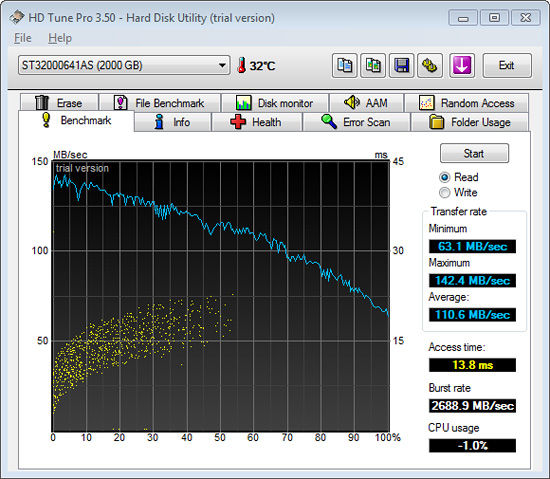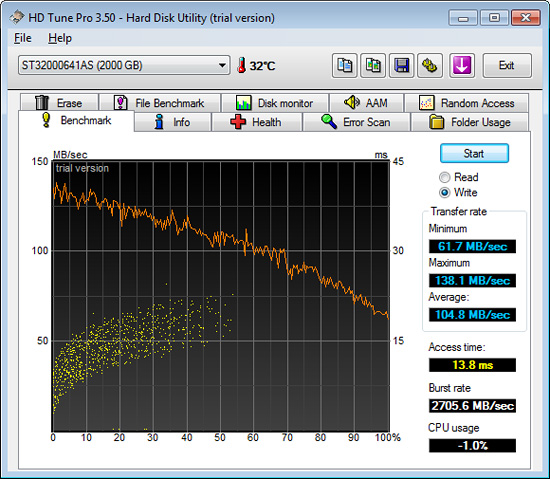Seagate Barracuda XT 2TB: SATA 6Gb/s Performance Preview
by Gary Key on October 29, 2009 12:00 AM EST- Posted in
- Storage
Seagate has finally started shipping their new Barracuda XT 2TB drives that feature the new 6Gb/s SATA interface based on SATA Revision 3.x specifications. We had an early preview of the drive a few weeks ago and finally received a production level item for review. Just as important, we now have retail motherboards from Asus and Gigabyte featuring 6Gb/s capabilities. Well at least the Marvell 88SE9123 chipset included on both motherboards is theoretically capable of 6Gb/s operation.
Asus and Gigabyte took a different approach to implementing the Marvell 9123 chipset on their motherboards. Asus’s top of the line P7P55D Premium (a very good board by the way, full review coming shortly) features a PEX PLX8613 PCIe bridge chip that will convert four of the P55’s PCIe x1 lanes (250MB/s each) into two 500MB/s lanes. While still short of the maximum theoretical 600MB/s transfer speed of the SATA 6G specifications, it will provide more than enough burst bandwidth for the first generation 6G hard drives. The benefit is that the 6G capability is always on without affecting the other capabilities of the board and the same PLX chipset will be utilized for the upcoming USB 3.0 (NEC chipset) option on their upper-end boards.
Gigabyte’s implementation will be utilizing an x8 PCIe 2.0 from the Lynnfield processor that will obviously provide more than enough bandwidth but the drawback is that CF/SLI capabilities will be disabled as only a single x8 PCIe 2.0 lane will be available to the GPU. The benefit in this approach is that the SATA 6G switch is disabled/enabled in the BIOS by the user based upon need. Since an additional hardware chipset like Asus is utilizing is not required, it should result in a slightly lower board cost. Gigabyte informed us this week that all P55A-xxx boards will feature both SATA 6G and USB 3.0 capabilities. We will compare the performance of Gigabyte’s solution against Asus’ implementation shortly.
For today’s preview we are utilizing the Asus P7P55D Premium motherboard, 8GB of GSkill’s DDR3-1600 Ripjaw memory, Asus HD5870 video card, Corsair 750HX power supply, Windows 7 x64 RTM, Western Digital Caviar Black 2TB HD, WD VelociRaptor 300GB, Intel X25-M G2 160GB SSD, and Seagate’s Barracuda XT 2TB HD. We will have a full review of both hard drives shortly with additional performance results along with temperature and noise tests.
We are utilizing the Intel 160GB SSD for our OS drive and comparing the Seagate XT drive to its closest competitor, the WD Caviar Black, on both the Intel P55 and Marvell 9123 controllers. The P55 is limited to SATA 3Gb/s operational mode when running either drive, while the Marvell controller will be operated in SATA 6Gb/s mode with the Seagate drive and in fallback 3Gb/s mode with the WD drive. We are utilizing Marvell’s latest 1027 driver and Intel’s 7.0.0.1013 driver set in AHCI mode.
HD Tune 3.50 Results -


See something strange, the read burst rate of 2766MB/s and write burst of 2705MB/s are incredible for single drive performance but like most synthetic test results, they are not a true indication of actual platform performance. The reason for these “outstanding” results is that Marvell’s latest driver allocates (dynamically) a portion of system memory for transfer cache operations. Intel’s own Matrix Storage Manager and JMicron’s latest driver set also utilize a similar approach. In fact, Windows 7 implements a similar type of caching at the kernel level that makes these driver optimizations redundant in some ways.
Marvell is using aggressive algorithms in this particular driver to read and write as much possible data out of the RAM cache as possible before relying on transfers via the hard drive’s own internal cache or reading/writing from the platter or NAND. In earlier driver sets from Marvell, they requested that Window’s write-cache buffer flushing option be disabled in order to gain the maximum benefit from the 9128 controller. From all indications, the 1027 driver automatically disables this function as our performance results were the same with it disabled or enabled.
While performance was generally up to 10% better with this driver compared to the earlier 1018/1025 driver sets, we have a problem with the write-cache buffer flush being disabled automatically. There is a potential for data loss or even file table corruption if the buffers are not flushed and written properly if power is lost or there is another problem with the system. Of course that potential problem even exists with the out of box drivers and with write-caching enabled.
Our concern is that the Marvell driver might not recognize file table priorities in the same manner that the kernel does and those journal entries will be placed into the same general cache queue with other mundane requests. That could increase the likelihood of data or table corruptions above the normal risk posed with write caching. We are still waiting on additional information about the driver design and will update our findings in the final review.










55 Comments
View All Comments
HangFire - Thursday, October 29, 2009 - link
This is what I expected- there is no real need for 6Gb/S SATA.SAS, on the other hand, which (for lower speeds, at least) uses the same connector technology, has a real need for 6Gb/S, since there is typically a RAID on the other end of the SAS cable.
Unfortunately, I didn't see even a passing mention of when, or if, this technology is coming to SAS.
7Enigma - Thursday, October 29, 2009 - link
Anand,Did you get your 3G and 6G mixed up? If not your first 2 charts showing your custom HD tests show the 6G 15-20% slower than the 3G. Your commentary doesn't say anything about the 3G/6G comparison, only the differences between the brands...
7Enigma - Thursday, October 29, 2009 - link
Yikes, I completely misread your comments. That's what I get for posting before double-checking. Please disregard my initial post!Pastuch - Thursday, October 29, 2009 - link
2TB Performance? Who cares... Give us more Anand Home Theater blogs! Now those are interesting!All we really want to know is if these new Seagates are more reliable than the Seagate 7200.11s or the WD Greens. In fact if you look at all of the drives over 1TB there are VERY FEW that are reliable.
The HD manufacturers need to forget 2tb and move to 4tb drives asap. My blu-ray backups already take up 5 Terabytes and it's growing exponentially.
If we wanted HD performance we'd be reading your SSD articles ;)
falc0ne - Thursday, November 5, 2009 - link
bluray backups...maaan are u nuts? :))this is an example with:"don't do this at home" :))
Woa you should have seen my 'weddings' bluray movie backup: it takes 2000TB maan i've attended to many weddings:)
Second thoughts: seriously thinking in asking IBM or Google to host my backups:))
JEDIYoda - Friday, October 30, 2009 - link
We all care about 2T performance nice review. Thanks for touching on things we all care about!!Nobody gives a fuck about 4T drives especially when only one person is crying like a weenie. Especially when that weenie is so misinformed about the reliability of drives ovcer 1T!!!
Muahahaha
kmmatney - Thursday, October 29, 2009 - link
"All we really want to know is if these new Seagates are more reliable than the Seagate 7200.11s or the WD Greens. In fact if you look at all of the drives over 1TB there are VERY FEW that are reliable."Exactly. The only thing that is really important with these large drives is how reliable they are. Youc an't really inlcude that in a review of a new product, but really this is way more important than all the other benchmarks. These drives are used for backup and storage and need to be reliable.
Gholam - Monday, November 2, 2009 - link
I don't really care about individual drive reliability. There is no drive that is 100% reliable, and as long as you take proper precautions, drive failures are inconsequential.SunSamurai - Thursday, October 29, 2009 - link
SIlly person, dont you see where the true potential of these lay?I would order 1000 of these for a server farm based on the simple fact that in the tests they are taking -1% CPU time. Over 1000 of these drives thats 10x cpu performance! =D
atlmann10 - Friday, October 30, 2009 - link
Wow Silly person that's an insult. Well Mr name caller, I would let you know that if you bought 1000 of these and ran your sever farm on SSD drives specifically, especially watching for upgrades in SSD tech you would be loosing. The SSD debate is over anyway now, as Intel said today that SSD drives could not diminish in nand size past 22nm today. What this means is that if it is at 32nm and we go by there tick/tock theory, and we also look at how fast this technology has been moving is, you would have no more than a year and a half max on your time line. After that there will be no greater Nand flash drives. So your server farm would die in a year and a half. I imagine you would recognize a return on your investment in 2-3 years. So if your giving away money I'll send you my address.